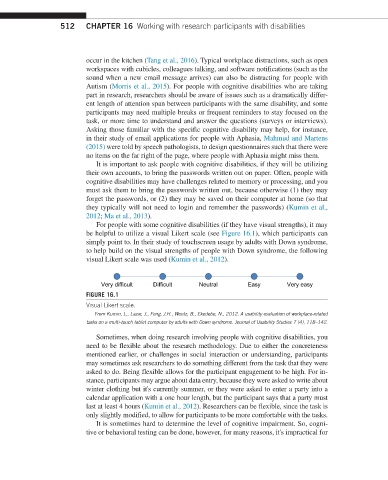Page 519 -
P. 519
512 CHAPTER 16 Working with research participants with disabilities
occur in the kitchen (Tang et al., 2016). Typical workplace distractions, such as open
workspaces with cubicles, colleagues talking, and software notifications (such as the
sound when a new email message arrives) can also be distracting for people with
Autism (Morris et al., 2015). For people with cognitive disabilities who are taking
part in research, researchers should be aware of issues such as a dramatically differ-
ent length of attention span between participants with the same disability, and some
participants may need multiple breaks or frequent reminders to stay focused on the
task, or more time to understand and answer the questions (surveys or interviews).
Asking those familiar with the specific cognitive disability may help, for instance,
in their study of email applications for people with Aphasia, Mahmud and Martens
(2015) were told by speech pathologists, to design questionnaires such that there were
no items on the far right of the page, where people with Aphasia might miss them.
It is important to ask people with cognitive disabilities, if they will be utilizing
their own accounts, to bring the passwords written out on paper. Often, people with
cognitive disabilities may have challenges related to memory or processing, and you
must ask them to bring the passwords written out, because otherwise (1) they may
forget the passwords, or (2) they may be saved on their computer at home (so that
they typically will not need to login and remember the passwords) (Kumin et al.,
2012; Ma et al., 2013).
For people with some cognitive disabilities (if they have visual strengths), it may
be helpful to utilize a visual Likert scale (see Figure 16.1), which participants can
simply point to. In their study of touchscreen usage by adults with Down syndrome,
to help build on the visual strengths of people with Down syndrome, the following
visual Likert scale was used (Kumin et al., 2012).
Very difficult Difficult Neutral Easy Very easy
FIGURE 16.1
Visual Likert scale.
From Kumin, L., Lazar, J., Feng, J.H., Wentz, B., Ekedebe, N., 2012. A usability evaluation of workplace-related
tasks on a multi-touch tablet computer by adults with Down syndrome. Journal of Usability Studies 7 (4), 118–142.
Sometimes, when doing research involving people with cognitive disabilities, you
need to be flexible about the research methodology. Due to either the concreteness
mentioned earlier, or challenges in social interaction or understanding, participants
may sometimes ask researchers to do something different from the task that they were
asked to do. Being flexible allows for the participant engagement to be high. For in-
stance, participants may argue about data entry, because they were asked to write about
winter clothing but it's currently summer, or they were asked to enter a party into a
calendar application with a one hour length, but the participant says that a party must
last at least 4 hours (Kumin et al., 2012). Researchers can be flexible, since the task is
only slightly modified, to allow for participants to be more comfortable with the tasks.
It is sometimes hard to determine the level of cognitive impairment. So, cogni-
tive or behavioral testing can be done, however, for many reasons, it's impractical for

